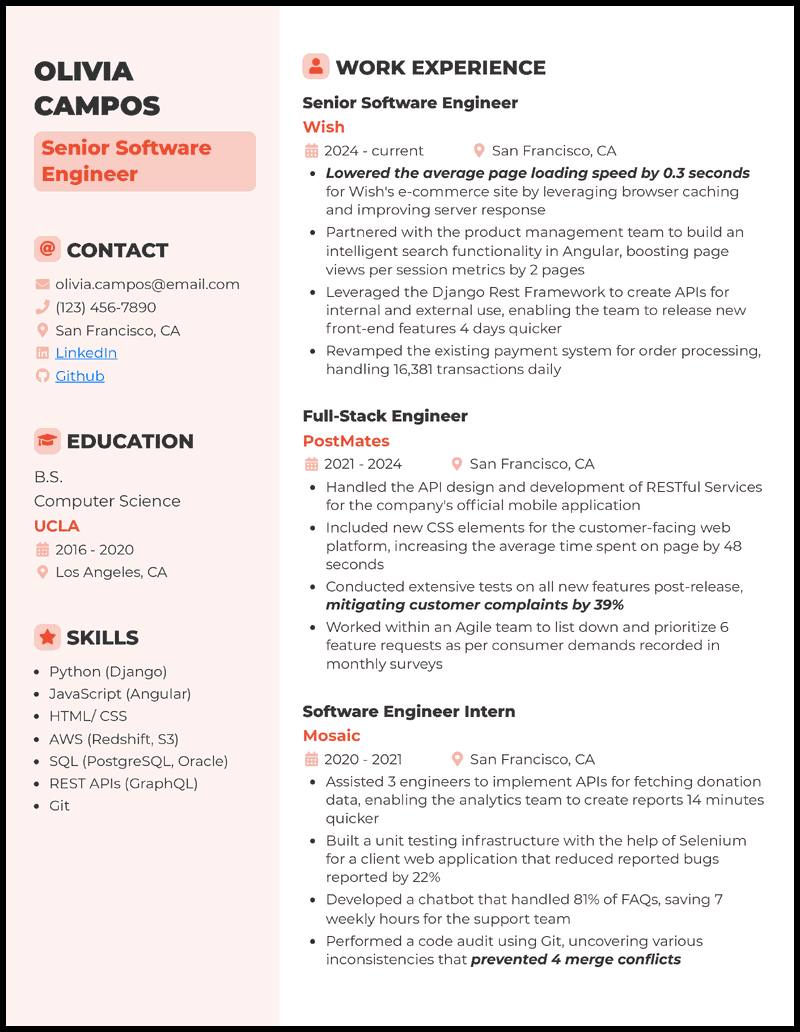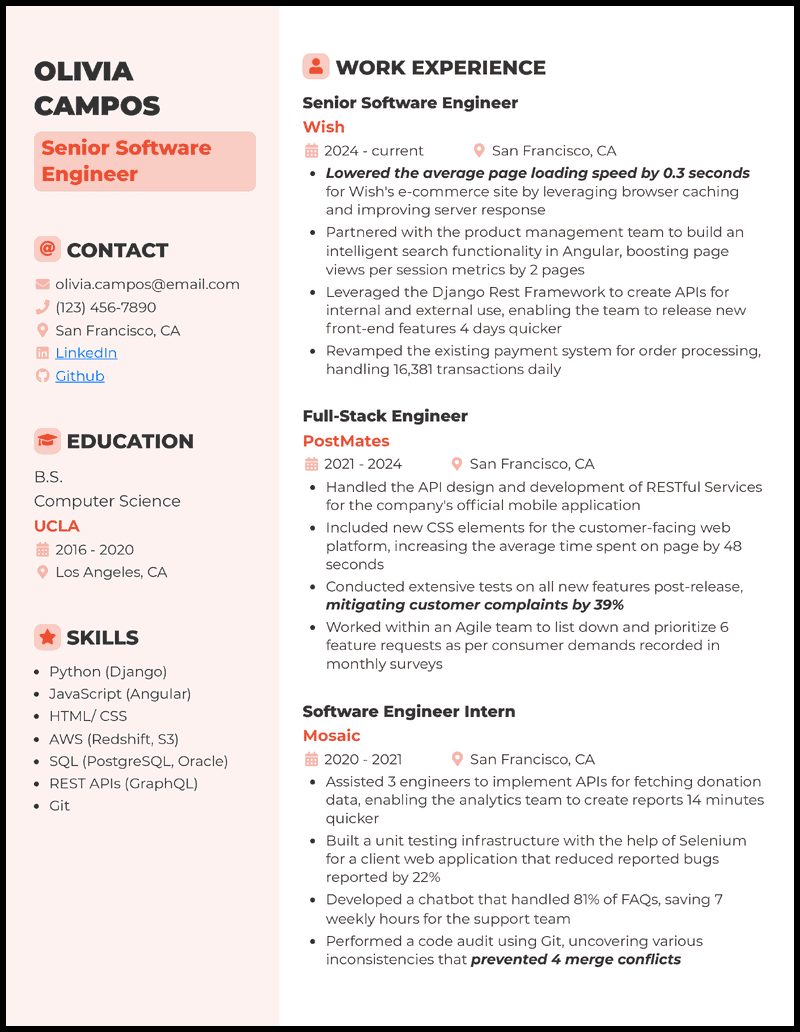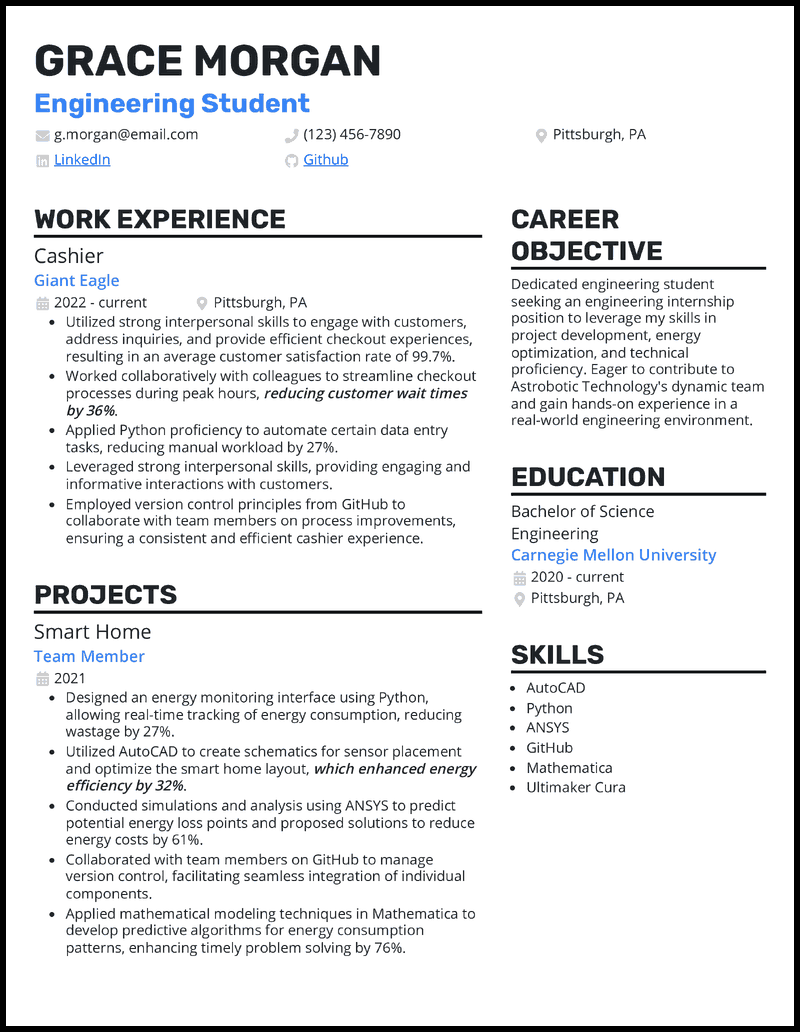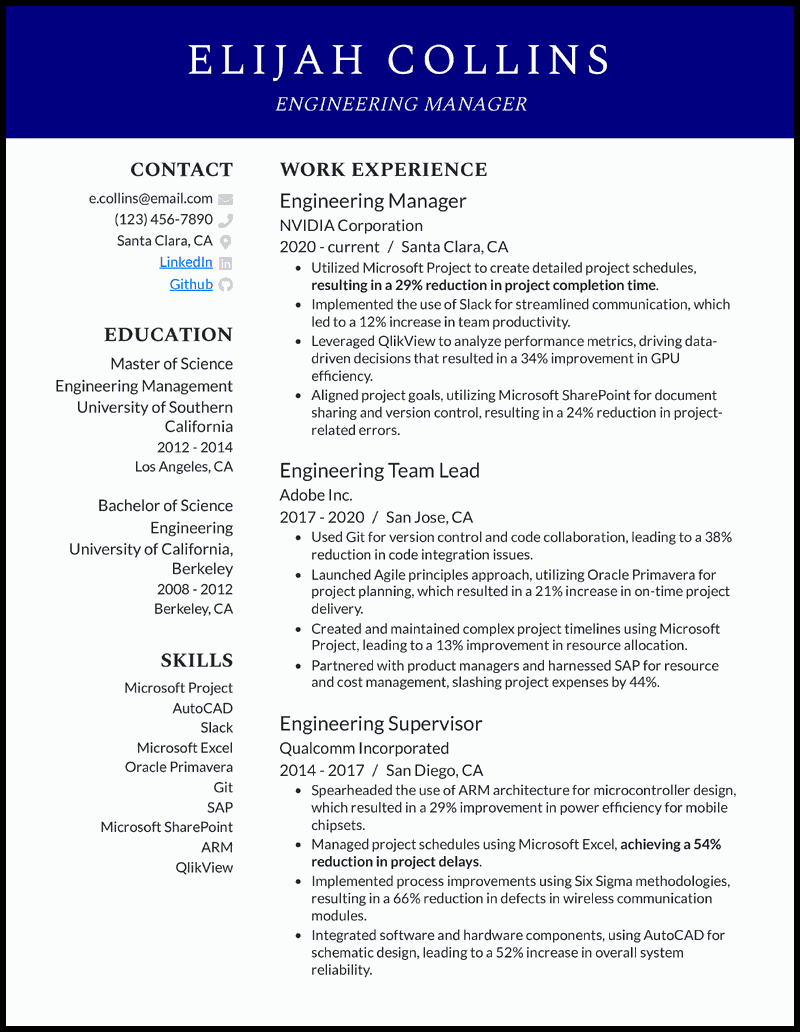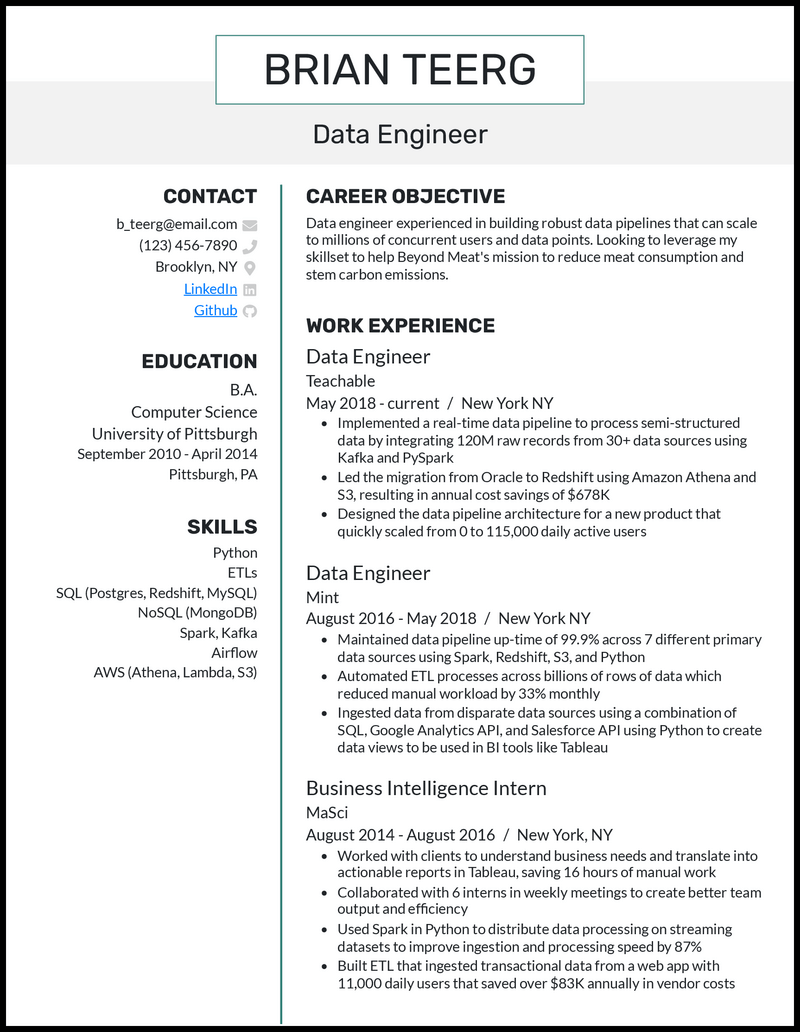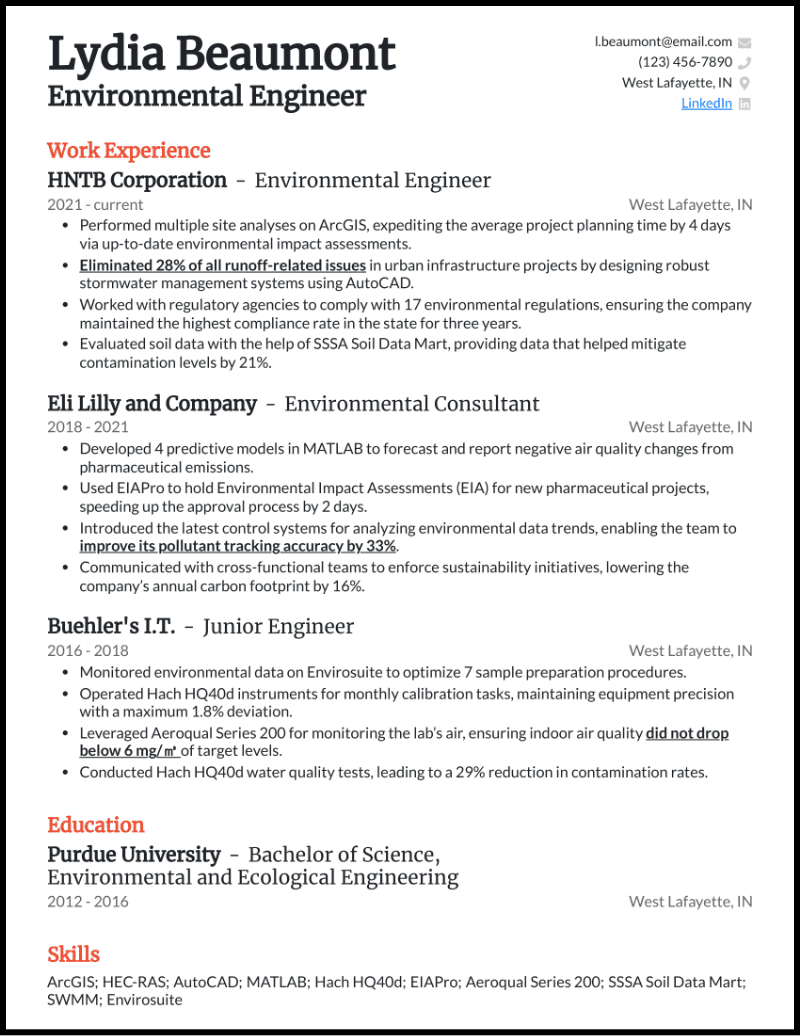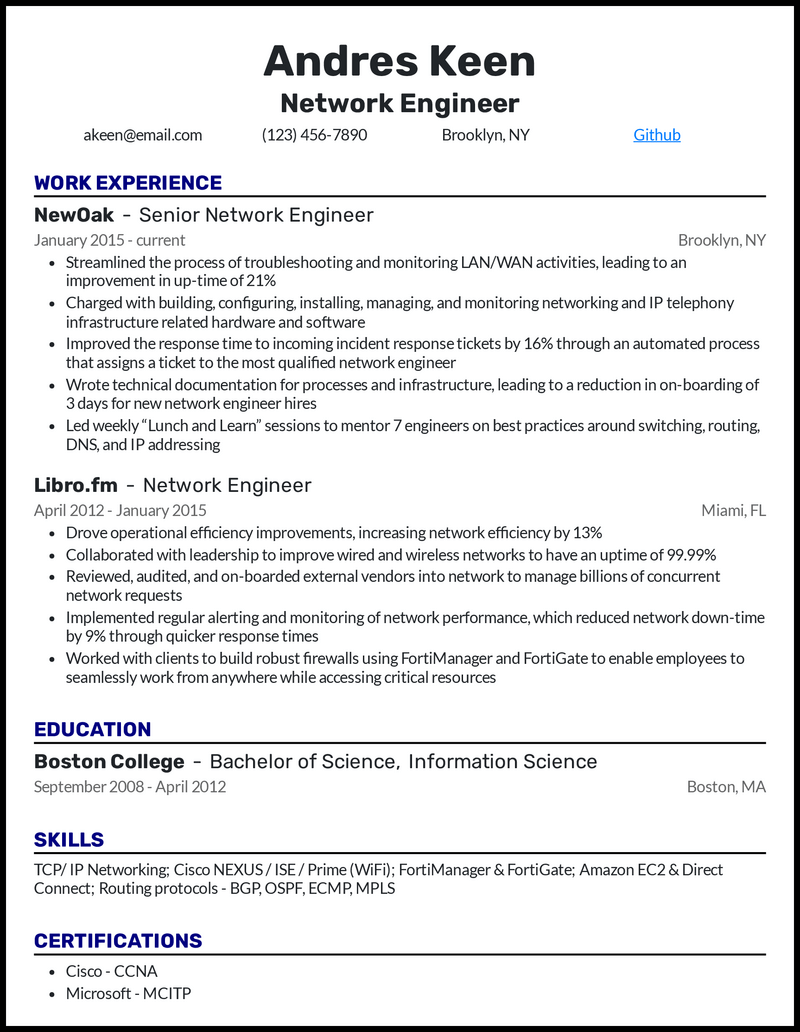
Engineering





Best for senior and mid-level candidates
Resume Builder
Like this template? Customize this resume and make it your own with the help of our Al-powered suggestions, accent colors, and modern fonts.
No matter what type of engineer you are, you’re rigorously logical with a penchant for numbers.
You shouldn’t also have to be an expert cover letter writer or resume maker to spotlight your abilities and land your next (or first) engineering job.
Getting started is the hardest part of building an engineering resume. Our 25 engineering resume examples are helping engineers get interviews in 2026, so they’re an excellent starting place for inspiration and valuable resume tips.
Why this resume works
- Your engineering resume should mention the technologies in which you have experience. You can list these tools, programming languages, or technologies in a dedicated resume skills section. We recommend limiting the web developer skills section to no more than 10 since a long laundry list can be a red flag to employers.
Why this resume works
- Be clear about the tech stack you’ve worked in at prior positions on your software engineer resume. It’s also a good idea to mention which programming languages and frameworks you’re most comfortable using. As a rule of thumb, only include a programming language on your resume if you can whiteboard coding solutions in that language.
View more software engineer resumes >
Why this resume works
- Your engineering student resume isn’t expected to have a lot of experience in the real world of your profession. That should not dim your hopes of landing the job. Your projects can fill that gap. Also, don’t overlook your proficiency in tools like AutoCAD, Python, and ANSYS.
View more engineering student resumes >
Why this resume works
- Your engineering manager resume can capitalize on your role in streamlining communication through Slack and SharePoint, as well as process optimization through Six Sigma. This strategy will establish you as a results-oriented professional capable of delivering exceptional outcomes in complex engineering environments.
View more engineering manager resumes >
Why this resume works
- Customizing your industrial engineering resume is all about adding relevant details from the job ad, or in layman’s terms, sprinkling the right keywords around your piece and seeing to it that your bullet lists address the needs specified in the job description. For example, let’s say they need someone proficient with AutoCAD; how about recounting using it to optimize layout design for equipment installations?
Why this resume works
- If you can, your data engineer resume should also show the impact your work has had on business. These can be estimates. Did you help increase revenue, site speed, or reduce manual reporting time? By highlighting your business impact, you make it clear to the hiring manager that you’re focused on what really matters to the business.
View more data engineer resumes >
Why this resume works
- Don’t shy away from including roles like Systems Engineer and Design Engineer in your aerospace engineering resume. These show that you’ve got experience in more than just developing aerodynamic models. You never know if things like CFD simulations and automating data integration are the extra skills an employer is looking for.
Why this resume works
- If you’ve had a long career in the biomedical field so far, you deserve a resume that does it justice without compromising bullet points into tiny text. That’s exactly what the Standout resume template is here for. Next, enrich your biomedical engineering resume in a neat reverse-chronological format.
Why this resume works
- Don’t fall into the trap of loading the work history of your engineering technician resume with every job you’ve ever had; that move will fall flat. Pick three roles relevant to the open position—think about an engineering internship, the time you rocked as an engineering assistant, and your most recent role as an engineering technician.
Why this resume works
- To secure a spot on that dream team, you’ve got to garnish your structural engineering resume’s work history section with quantified outcomes. Number-backed phrases, such as “Developed and optimized 3D models with Tekla Structures for a $52M bridge project put your value under the spotlight.
Why this resume works
- Skip the small stuff and include your best achievements. We’re talking things like lowering project completion times, lowering deployment errors, keeping production downtime at a minimum, and staying within budget. Make sure that every bullet point of your senior engineer manager resume highlights how your leadership brought a positive change.
Why this resume works
- If you don’t have any past-related projects, then start off by talking about your skills in important tools like AutoCAD and programming languages like MATLAB. Also, remember to tailor the objective of your college engineering resume to the company you’re applying to.
Why this resume works
- Ensure that your environmental engineering resume reflects your passion with specific skills. Employers will naturally expect you to be a team player so focus on including key software like SSSA Soil Data Mart, Envirosuite, and HEC-RAS. Make them a testament to your ability to handle tasks like site analysis and soil evaluation.
Why this resume works
- Ideally, you want your VP of engineering resume to radiate authority and speak volumes about your passion for innovation. What’s truly going to help you seal the deal is quantified bullet points. Using wording like “Led Jira integration… shortening sprint cycle times by 2 days” shows that you’re capable of handling managers and expediting agile processes.
Why this resume works
- A good way to create a standout petroleum engineering resume is to show that you received a headstart in the industry early on. Use any project or internship experience from your university days, even if you completed it within the last year. Craft bullet points that emphasize how you learned important skills like mitigating fracturing fluid and optimizing drilling strategies.
Why this resume works
- We get it—capitalizing on creative resume designs seems like a slick move to add visual interest to your sales pitch. Unfortunately, they could make you look unprofessional and hurt your interview chances in the long run. What a bummer. Go with a simple resume template. You’re aiming for something that is easy to read and draws attention to your qualifications.
Why this resume works
- If you’ve worked hard to earn certifications (CCNA, MCITP, etc.), list them in a dedicated “Certifications” section on your network engineer resume. Doing so makes it clear to the hiring manager that you have the required technical skillset.
Why this resume works
- No one can become a pro geotechnical engineer overnight. That’s why showing healthy career growth can help you create an authentic geotechnical engineer resume. You can add your previous roles where you completed geo-specific tasks like developing geotechnical models and evaluating soil samples.
Why this resume works
- Give some spotlight to past projects in your Mizzou engineering resume. Even a simple project like being a model presenter can do wonders if you play your cards right. Did it include key mechanics-related quantities like stress points? Answer them in your bullet points and you’ll be quantifying key impacts before you know it.
Why this resume works
- Yes, you only have a few seconds to impress the recruiter, which is why we propose accentuating a few remarkable achievements on your financial engineering resume. For example, by bolding phrases like “…assess credit risk for 53 clients” and “…managing $513M in assets”, you signal your potential impact.
Why this resume works
- Normally, for a job at this level, creating a two-page head of engineering resume seems most fitting, but we don’t recommend stretching things out just to fit the mold. Think you can highlight your leadership chops in just three stellar work experiences? Shoot for a one-page resume. Include your latest job at the top and let older roles fill the remaining spaces as you go toward the bottom.
Why this resume works
- For a PhD engineering resume that pivots you into a new career phase, capitalize on the proper diction to sell yourself as the ideal fit. Our advice is to refrain from using jargon in your pitch unless you want to irk the hiring manager and sink your chances. We are all for leveraging simple language to describe your relevant job experiences and other qualifications.
Why this resume works
- How could adding a photo of yourself to your materials engineering resume be a bad move? Adding a picture to your resume doesn’t just shove you into the world of employee discrimination based on appearance, gender, or race. The electronic bouncers that are ATS bots don’t play nicely with visuals. And the potential outcome? Recruiters might never even see your application.
Why this resume works
- When your scanty experience is compelling you to send out your junior engineering resume as soon as you see that job posting, remember that “Haste makes waste.” Our point? Don’t you dare hit that “Submit” button before you give your showpiece a thorough once-over for grammar and spelling slip-ups that might be lurking about, ready to jeopardize your work.
Why this resume works
- As you gain experience in DevOps, your education section should take up less and less space on your resume template. Keep your DevOps engineer resume to one page because real estate is gold. Instead, make your work history what really shines on your resume.
View more DevOps engineer resumes >
How to Format an Engineering Resume

How you format your engineering resume can determine whether you get an interview. Your resume needs to be in a logical format that can be quickly reviewed and should include all necessary information. If you leave important details out of your resume, you won’t have the opportunity to prove yourself.
Let’s briefly explore our three best tips for resume formatting for engineers:
- Reverse-chonological, functional, and combination/hybrid formats
- Contact info and header
- ATS & readability

Reverse-chronological, functional, and combination/hybrid formats
Engineering Resume Formats
- It sounds more complicated than it is. Reverse chronology means the information listed on your resume begins with the most recent experience. For example, your current job, which you began five years ago, is listed at the top. The job you had before is listed right below it.
- The functional resume format focuses on your skill set over your experience. The functional resume is also known as a skills-based resume because it focuses on how your skills and abilities qualify you for a job. For example, you could focus on a skill set you’ve used for several jobs. Even if the job were 20 years ago, your experience would still help you today. Using MySQL in your very first job will still be relevant if the job for which you’re applying also requires MySQL.
- The combination/hybrid resume format is exactly what it sounds like. You combine the best parts of a functional resume with a reverse-chronology resume. This is done by including a skills section first, followed by your experience. It immediately shows employers your skill set and experience.
Engineering is definitely a field that has plenty of opportunities for career progression. in 2026, reverse-chronology formatted resumes are best for engineers because they show your most recent experience first, as well as an increase in responsibilities over time. Also, this format lets you include more details for more recent positions and less information for older jobs.

How to format your engineering resume’s header and contact information
You’ll want your header to stand out professionally. Many of the resume examples we have show your name in large letters at the top of your resume. We recommend the following:
- Use a font size of at least 16 points.
- Use a Serif font like Times New Roman, Helvetica, or Bookman Old Style.
- Avoid cursive or curly fonts.
- Write your name in bold colors like black or dark blue.
- Avoid overly bright colors like purple or orange.
Also, include the title of the position you’re applying for directly under your name. Are you applying to be a DevOps Engineer? A Network Engineer? A Data Engineer? Your future employer should know the position you’re applying for right away.
Additionally, you’ll want your contact information close to your name. Some resume writers put this information directly under their names, but you can also place this at the top of the sidebar. Include the following information:
- Your phone number
- Your email address
- Your city and state
- Links to professional networking sites like LinkedIn or GitHub
When it’s all said and done, your engineering resume header may look something like this:
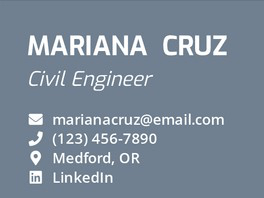

Will your engineering resume make it through ATS?
Most employers use an Applicant Tracking System (ATS) to filter through resumes. If your resume is hard to read, the ATS could nix it from the system before employers ever have a chance to look at it. For this reason, you’ll want to take the following steps to ensure your resume is ATS-compatible:
- Don’t use charts or images in your resume.
- Use simple, round bullet points; complex graphics don’t make sense to ATS.
- Include keywords from the job listing in your skill set.
- Save your document in .pdf and .docx.
To save you a headache, we think you’ll love using our AI resume builder, automatically ensuring your resume is ATS-friendly.
How to Write an Engineering Resume

When writing your engineering resume, remember to include measurable business impacts that resulted from your solutions. With companies now coming to a no-hire, no-fire position with layoffs, you’ll need to pass strict ATS filters and employers to truly shine.
To get past them, you need to directly mention important KPIs, such as cost savings, increased customer satisfaction, or system performance improvements. This section will largely cover:
- The best in-demand skills every engineer should have
- Strategies for quantifying your engineering bullet points
- Tips on tailoring your engineering resume to specific roles

Do you need an objective or summary for your engineering resume?
Your objective for your resume is to get a job. If you write an objective, you’ll want to clearly discuss what type of job you’re seeking. A summary is different. Its focus is to give a brief synopsis of your whole resume.
Poor resume summary example
Skilled DevOps engineer with 10 years of experience in nodes, infrastructure, and server management. Excellent at time management and saving companies money.
This summary is ineffective because the information can be gathered from other resume sections. It’s a waste of space that could be used for other things. Here are a couple of examples of strong objectives.
Good resume summary examples
Experienced developer with 8 years of experience in full-stack, consumer-facing applications. Wanting to transition to B2B applications to improve interactions between small and medium-sized businesses at a company like OpenEd.
Veteran data engineer with 5 years of experience in B2B applications. Looking to switch to DevOps engineering to focus on improving overall company efficiency by improving applications through user interface.
Both of these examples work because the objective is:
- Cleary written; we know what the applicant wants
- Experience is stated
- Desire for growth and change is appropriate
- A clear motive is evident; the applicant isn’t floundering

How to make your engineering work experience stand out
Your most relevant experience should be listed first. We recommend listing two to four jobs that best show your qualifications for the position to which you’re applying. You don’t need to list more than four jobs, nor do you need to list every job you’ve ever worked. The employers who review have limited time, and they want to quickly see what you have to offer.
How to write your engineering resume bullet points
It’s easy to sink or swim regarding job description bullet points. Check your resume for the following:
- Use action verbs and active language. This includes writing in the present tense and using verbs that show action. “Being” verbs (are, is, was, were) are not your friend here. “Action” verbs (collected, sampled, organized) show strength and a strong skill set.
- Avoid using personal pronouns. Saying “I” is superfluous since the recruiter already knows you’re talking about yourself. Instead, allow the action verb to drive your actions forward (Example: Collected samples of different websites…).
- Punctuation is optional. Either include punctuation everywhere or completely omit it.
Not every bullet point is created (or, rather, written) equally. Here are some poor bullet points:
- Designed the EmptyNest app
- Fixed bugs and looked at reviews for future app updates
- Updated the app coding once a month
These bullet points are weak because they don’t provide any information. What is the EmptyNest app? Who’s it for? What functions does the app perform? What kind of bugs did he fix? Why were user reviews important? What kind of coding updates did he make?
While you can’t include every single detail about your work, asking these kinds of questions will get you headed in the right direction. Here are the same bullet points, written strongly:
- Designed an app called “EmptyNest” to help parents transition to children moving out of the home
- Updated app to omit long loading periods for chat features to encourage 32% higher user engagement in the “Chat” feature
- Analyzed user feedback to implement monthly changes to the app, which increased users by 82% over a six-month period
These bullet points work because they provide details that help recruiters understand the project, demonstrate accomplishment and success, and prove ability through numbers. Metrics are vitally important, so let’s dive into that next.
How to quantify your impact as an engineer
For engineers, quantifying your impact is a crucial part of showing your success. The numbers tell the whole story. While this is daunting, it works in your favor if you successfully implement quantities and qualifications. Try to include metrics in about 60 percent of your bullet points.
We recommend the following steps to quantify your impact:
- Use data to show how solutions are being created to correct problems:
- Detected mechanical problems in wind turbines and developed repair methods to prevent loss of more than $7M
- Show how changes increased profit or saved time:
- Designed robotic arm to aid in gastrointestinal surgical operations, which cut surgery hours by 80%
Quantifying your impact will show employers how valuable your work is and why they should consider you for their position.

What top engineering skills to include in your resume
Including your skillset is essential for any resume. How you present skills on your resume is important. You want both your hard and soft skills to show.
Your soft skills are the ones you can’t easily show on paper. For example, managing conflict and communicating with others are imperative soft skills. Your hard skills include software you’ve mastered and programs you use. It’s easy to show proof of your work.
- Look for keywords from the job ad description. Implement them throughout your resume to pass ATS software.
- Include four to five hard skills relevant to the job.
- Include soft skills if they’re highly relevant to the position; you should list fewer of these than your hard skills.
- Limit the skills you share so that your best shines through. Extraneous info is not needed.
- List your skills based on your experience level.
There are countless types of engineers, so you’re an aerospace engineer, civil engineer, chemical engineer, etc., these skills are a broad overview of what will serve you well:
- Math and physics
- Project management
- Analytically minded
- Interpreting blueprints
- CAD
- Design
- Data analysis
- Research
For instance, if you’re a civil engineer, the skills section on your engineering resume may look like this:

Additionally, software engineering is a rapidly growing, evolving field, and if this is you, here are some of the most sought-after skills:
- Python (Django)
- Java (Spring)
- Ruby (Ruby on Rails)
- PHP (Laravel)
- Javascript (Node, React, Vue, jQuery)
- SQL (MySQL, PostgreSQL, NoSQL)
- HTML5
- CSS
- AWS, GCS, Azure
- Unix
- Git

How to include your engineering education and certifications
If you’re an engineer, you’ll have your bachelor’s degree at a minimum. You may even need a master’s degree, and some jobs even require a doctorate.
Education is important to being an engineer. Without it, you couldn’t perform many of the functions of your job. And in a constantly evolving world and workforce, high pressure is placed on engineers to stay at the top of their game. This includes continuing education and becoming certified in new programs as they come out.
Many states have strict requirements regarding continuing education. For example, a certain number of hours of continuing education may be required to keep certifications and licenses. There isn’t a one-size-fits-all requirement. In fact, these requirements can vary by state and by the job.
If you’re an Engineer-in-Training, list the following:
- Relevant class projects that will help in an entry-level position
- Internship experience
- EIT Certification
- Your degree and GPA (if it’s at least 3.2)
If you’ve been in the field for less than 10 years, list the following:
- All the relevant experience that should be included for ATS
- List your most recent jobs in reverse-chronology
- List continuing education and certifications in reverse-chronology
- Certifications should be job relevant, like for inspection, design, or reliability
- Include your degree
If you’ve been in the field for 10 to 20 years, list the following:
- Detailed bullet points with job description keywords to satisfy ATS
- List the jobs that gave you specific experience for this job
- List continuing education and certifications in reverse-chronology
- Advanced certifications, such as board certified
- List your degree

When should you add projects, interests, or hobbies to your engineering resume?
Most engineering jobs don’t provide room for your interests or hobbies on your resume. The exception to this is for entry-level positions. If you’re a brand-new college grad, you’ll need to list advanced projects from your collegiate experience. Discussing your interests and hobbies through your projects will show passion for your career field and encourage employers to give you a chance.
Listing interests and hobbies can help you nail a job if it’s a close call between you and another candidate. If you’re equally qualified, being a “better fit” for the company could work in your favor. You don’t have to include interests or hobbies, but doing so might benefit you when you’re starting out, especially if you’re looking for a trendy startup that’s likely to care more about cultural fit.

How to tailor your engineering resume to each position
We know it would be easier to make one resume that you submit to dozens of different jobs. But this won’t result in success. In fact, you aren’t likely to score any interviews using this method. ATS will weed your resume out for missing job keywords.
You’ll need to tailor each resume to each job you apply for. Some drafts of your resume will be very similar to each other. Others may look quite different. Adjust your bullet points, skills, and objective/summary for each job. While it takes time, your efforts will be worth it!

Edit and proofread your engineering resume
Engineers are perfectionists by definition. Because of this, it’s important to have a flawless resume. This is where editing and proofreading come in. It’s often overlooked because most resume writers just want to be done. After all, drafting a resume can take hours, but using our free resume maker can save you lots of frustration and time.
We recommend taking the following steps when editing and proofreading your resume:
- Take advantage of our resume checker to make sure your resume is complete and is using the best techniques.
- Look for mistakes at least twice, preferably thrice!
- Get a second pair of eyes to look over your resume.

What mistakes do engineers make on resumes?
Engineers, especially those starting out in the workforce, can make mistakes on their resumes, which can lead to rejection of their applications. Here are some of the most common mistakes you should know about to avoid them:
- Mentioning tools without context
- Lack of quantified achievements
- Overloaded technical jargon
- Too many unrelated projects
- Poor formatting and ATS optimization

Key takeaways
- Include tools and describe their use in each bullet point explicitly.
- Include certifications and licenses in separate sections.
- Use a reverse-chronological format to list your best engineering stints first.
Land an Interview & Win Your Dream Engineering Job
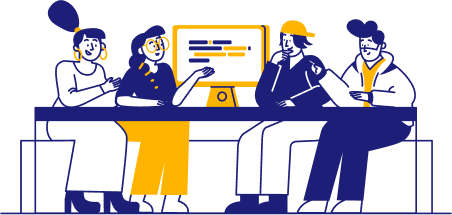
Keep the following in mind:
- Format your engineering resume in reverse chronology.
- Include accurate, clear contact information.
- Consider whether you need an objective or a summary.
- Use action verbs, and quantify your impact.
- Include your top skills that are most relevant to the position.
- List additional info, like education, certs, projects, interests, and hobbies.
- Tailor your resume to the job with keywords from the job ad to pass ATS.
- Edit your resume to catch careless mistakes.
- Use our AI resume makerto start and finish in as little as 12 minutes.
Congratulations on writing your resume. It’s the first and most important step to getting a job. Without a resume, you can’t submit any applications. But with the right resume and your engineering cover letter complementing it, you can score the perfect job.
Engineering Resume FAQs

To write an engineering resume, include the basics like your personal details, education, skills, and work experience. Use a clean, professional layout with standard fonts and avoid flashy graphics to ensure your resume easily passes through Applicant Tracking Systems (ATS).
As you choose your engineering resume template, you should adhere to the demands of the job description and the position you’re applying for. You want a piece that presents your best qualifications and strengths and convinces hiring managers of your suitability. Whatever template you choose, ensure it is easy to read and clearly defines each section with headings. That way, your resume will pass ATS and impress potential employers when they review it.
Your engineering skills are the most crucial part of your resume. They align you with what the job description demands and what the industry expects from professionals. Don’t just list skills; show how you’ve used them to make an impact and drive innovation and efficiency in your previous roles.
Your engineering resume summary must concisely describe your skills, measurable achievements, and past work experiences. This statement is the centerpiece that makes or breaks your qualifications, giving recruiters an easy time to decide if you’re the right candidate. It’s also crucial to ensure that your statement matches some of the keywords from the job posting.




